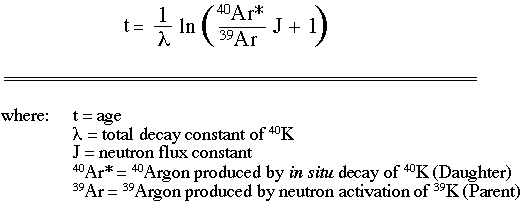The assumptions made are When the radiometric clock was started, there was a negligible amount of 40 Ar in the sample.
Potassium-argon dating | www.mfarrow.com
The rock or mineral has been a closed system since the starting time. The closure of the system was rapid compared to the age being determined. Dating with 39 Ar and 40 Ar depends upon the fact that the 39 K can be bombarded with neutrons in a nuclear reactor to produce an amount of 39 Ar which is proportional to the potassium content of the sample. The conventional potassium-argon dating process is technically difficult and usually is carried out by analyzing for potassium in one part of the sample and measuring 40 Ar in another. The Ar-Ar process can be done on the same small piece of a sample, analyzing for both gases in a mass spectrometer.
The bombarding of a geological sample with neutrons produces a population of 39 Ar which is proportional to the 39 K content of the sample. The proportionality is related to the probability or " cross-section " for the nuclear interaction. One of the complications that must be monitored is that of the production of 39 Ar by neutron scattering from the calcium content of the mineral sample.
There are also complications with the atomospheric argon content and various argon contamination scenarios. The details are best pursued in a dedicated text like McDougall and Harrison.
Argon–argon dating
This allows the 39 Ar population to be used as a proxy for the 40 K content of the sample to make possible the calculation of the age for the sample. This simplified conceptual treatment does not give a fair picture of the detailed design and execution of age determinations for a wide variety of types of geological samples. But it hopefully makes the point that Ar-Ar dating can take data from small samples based on mass spectrometry.
It has contributed to the vast collection of age data for earth minerals, moon samples and meteorites. The Cretaceous-Tertiary boundary in the geological age scale was associated with an iridium-rich layer which suggested that the layer was caused by an impact with an extraterrestrial object.
Keep Exploring Britannica
Because that time period, commonly referred to as the K-T boundary, was associated with the extinction of vast numbers of animals in the fossil record, much effort was devoted to dating it with potassium-argon and other methods of geochronology. The time of 65 million years was associated with the K-T boundary from these studies. Other large impact craters such as the Manson crater in Iowa dated to 74 My were examined carefully as candidates for the cause of the extinction, but none were close to the critical time.
- lbk dating.
- K–Ar dating - Wikipedia.
- Clocks in the Rocks.
- .
- matchmaking by name online free.
Chicxulub was not so obvious as a candidate because much of the evidence for it was under the sea. More attention was directed to the Yucatan location after published work by Alan Hildebrand in demonstrated the chemical similarity of Chicxulub core samples with material found distributed in the K-T boundary layer. Carl Swisher organized a team to produce three independent measurements of the age of intact glass beads from the C-1 core drill site in the Chicxulub impact area. The measurements were done by the argon-argon method.
Even this extraordinary matching with the age of the K-T boundary was insufficient to convince many geologists.
- russische dating site fotos.
- Argon–argon dating - Wikipedia.
- Navigation menu.
- .
- Potassium-Argon Dating.
- Potassium-argon dating.
The team proceeded to date spherules of glass found in Haiti to provide another bit of evidence. Many pieces of glass ejecta had been found on Haiti, which is over a thousand miles from the impact point currently. But geologists project a much smaller distance between the points at the time of the impact because of measured sea floor expansion. The Haitian spherules were measured to have age to melting of The sample is generally crushed and single crystals of a mineral or fragments of rock hand-selected for analysis. These are then irradiated to produce 39 Ar from 39 K.
The sample is then degassed in a high-vacuum mass spectrometer via a laser or resistance furnace. Heating causes the crystal structure of the mineral or minerals to degrade, and, as the sample melts, trapped gases are released. The gas may include atmospheric gases, such as carbon dioxide, water, nitrogen, and argon, and radiogenic gases, like argon and helium, generated from regular radioactive decay over geologic time.
The J factor relates to the fluence of the neutron bombardment during the irradiation process; a denser flow of neutron particles will convert more atoms of 40 K to 40 Ar than a less dense one. However, in a metamorphic rock that has not exceeded its closure temperature the age likely dates the crystallization of the mineral.
Thus, a granite containing all three minerals will record three different "ages" of emplacement as it cools down through these closure temperatures. Thus, although a crystallization age is not recorded, the information is still useful in constructing the thermal history of the rock.
Potassium-Argon Dating
Dating minerals may provide age information on a rock, but assumptions must be made. Minerals usually only record the last time they cooled down below the closure temperature, and this may not represent all of the events which the rock has undergone, and may not match the age of intrusion. Thus, discretion and interpretation of age dating is essential.

This technique allows the errors involved in K-Ar dating to be checked.
.jpg)